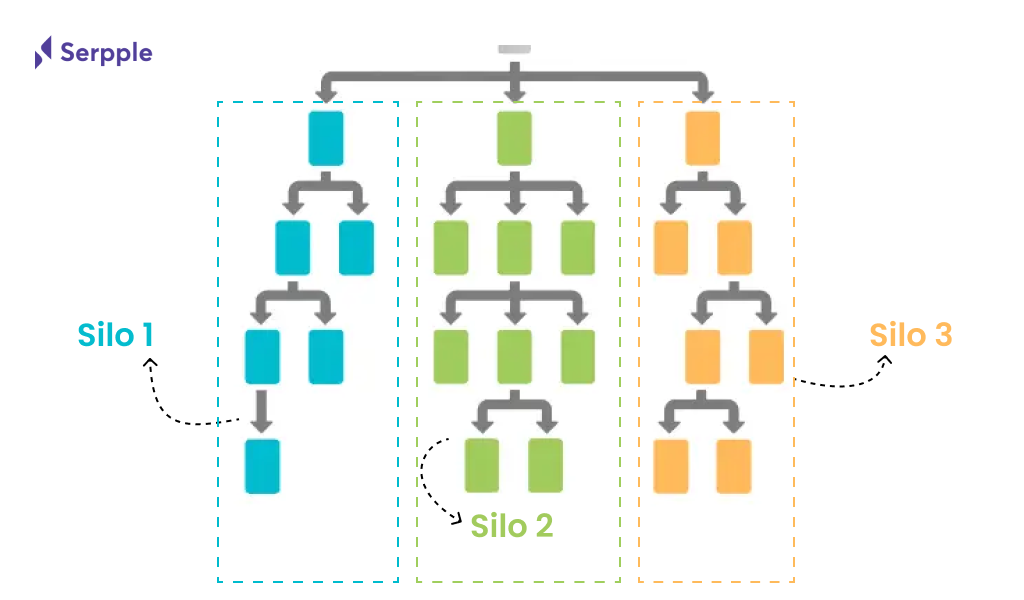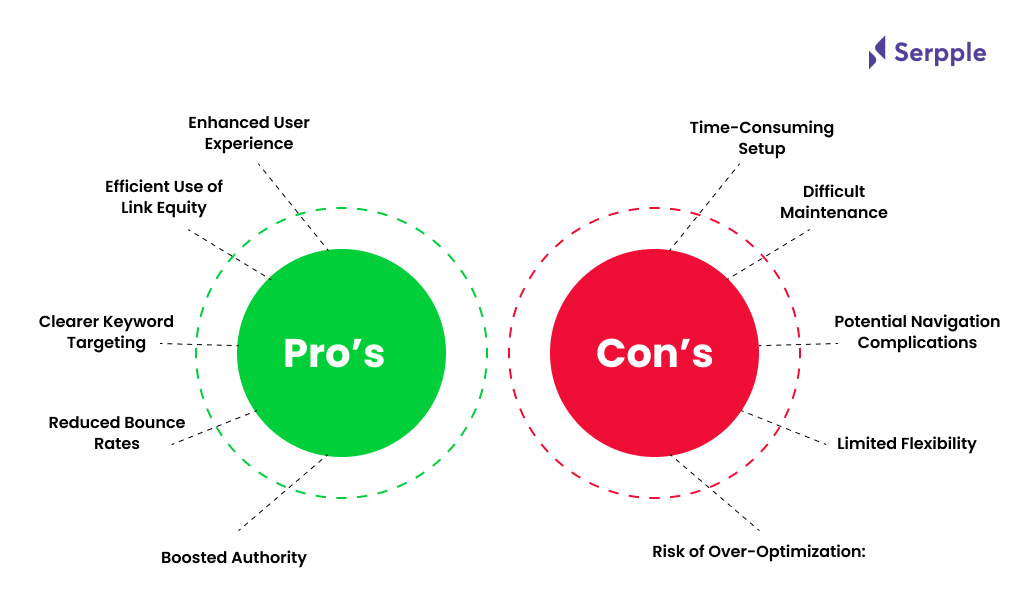Website SILO architecture in SEO sounds like a fancy term, right?
With SEO getting more complex and with different factors to rank on search engines to consider, marketers have a number of strategies to drive organic growth.
SILO is the organization or arrangement of something that makes it easy to be found out when needed and this whole process is known as “SILOING”.
Imagine you have got a big box of Legos. Now if you keep them all mixed up, it’s going to be hard to find the piece you want.
But think of it by arranging it into smaller boxes by color or shape, it becomes quite easy to now pick the one needed.
In the same way, Google crawlers or web crawlers when find this neat arrangement on your website, it makes it easy for them to understand your content.
But, here’s the big question. Should you do SILO in 2024?
Let’s find out!!
What is Website SILO Architecture in SEO?
SILO architecture in SEO is all about creating order and clarity on your website or rather web pages. It’s a system of sorting and categorizing your content into different sections or “silos” that are related to a common theme or topic.
These silos not only group similar content together but also help guide the flow of internal links, the hyperlinks that connect one page on your site to another. Let’s dig a bit deeper!
Think about the pages on your website as if they were chapters in a book. In a well-organized book, related chapters are grouped together into parts or sections.
Similarly, in a website using SILO architecture, related pages are grouped together into silos. These silos can be based on your services, products, blog topics, or any other themes that are relevant to your website and business.
Internal links play a significant role in this architecture. These links connect different pages within the same silo, guiding users and web crawlers from one piece of related content to another.
This not only improves the user experience by making navigation more intuitive but also makes it easier for web crawlers to understand the structure and content of your site.
When you link pages within the same silo, you’re telling web crawlers that those pages are closely related and important. This can improve the search engine ranking of these pages, as search engines like Google consider the structure and internal linking of a site when determining its relevance to a search query.
Pros & Cons of Doing SILO?
As with any SEO strategy, SILO comes with its own set of pros and cons. Understanding these will help you make an informed decision about whether to implement this architecture on your site or not. Let’s take a look at some of the benefits and drawbacks of using SILO.
Pros of Using SILO:
- Enhanced User Experience: SILO structure leads to a well-organized website, which makes it easier for visitors to navigate and find the information they need.
- Efficient Use of Link Equity: When you link pages within the same silo, you concentrate on link equity, enhancing the SEO value of each page within that silo.
- Clearer Keyword Targeting: Each silo in the architecture can focus on a specific keyword or set of related keywords, making your keyword targeting more precise and effective.
- Reduced Bounce Rates: A well-structured site helps users find what they’re looking for quickly and easily, which can lead to lower bounce rates.
- Boosted Authority: By grouping related content together, each silo can become a source of authority on its particular topic, which can increase your website’s credibility.
Cons of Using SILO:
- Time-Consuming Setup: Establishing a SILO architecture requires a significant investment of time and planning. You’ll need to thoroughly audit your site’s content and potentially restructure much of it.
- Difficult Maintenance: Once the SILO structure is in place, making changes or adding new pages can be complex, as it may require adjusting your entire website silo structure.
- Potential Navigation Complications: If not implemented correctly, a SILO structure could make navigation more confusing for users, especially on larger websites with numerous silos.
- Limited Flexibility: Because each silo focuses on a specific theme or keyword, it can be challenging to include content that doesn’t fit neatly into one of your predefined silos.
- Risk of Over-Optimization: There’s a chance of over-optimizing your website for search engines, which could lead to penalties if your website SILO structure is seen as an attempt to artificially boost SEO rankings.
With these pros and cons in mind, you’re now better equipped to evaluate the SILO architecture for your own website. It has the potential to enhance user experience, clarify your keyword targeting for your webpage , and even boost your website’s authority.
On the flip side, it’s important to consider the effort required in setting up and maintaining a SILO structure and the potential risks it might carry.
Should You Do SILO in 2024?
Indeed, implementing the SILO structure can be a smart move to organize your website’s content. However, it’s not a one-size-fits-all solution and its effectiveness can depend on various factors, including what’s working in your particular domain.
To determine whether SILO is the right move for you in 2024, it’s wise to do some groundwork.
Here are a few steps to help you make that decision:
1. Check what competitors are doing:
One of the most effective strategies for SEO planning involves looking at your competitors. This approach isn’t about copying, but learning and strategizing.
Analyze several competitors who are doing well in your industry, especially those ranking high on search engines. How are they structuring their website? Is there a noticeable SILO structure in place?
What type of content are they including in each silo? Are they using specific keywords for each silo? Studying your competitor’s website can give you a practical perspective on how to effectively employ a SILO structure.
Furthermore, you can look at the feedback they are getting from their audience.
This can give you an idea of whether their SILO structure is appreciated by users, or if there are areas of dissatisfaction you could improve upon. Here’s a guide on SEO competitor analysis that may help you along the way.
2. Understand Your Content:
Your content is the essence of your website, and understanding it thoroughly is critical.
Conduct a detailed audit of your existing content. This should include categorizing all your articles, blog posts, product pages, and any other content into broad topics. Then, look at each category.
Are they distinct enough to form individual silos? How broad is each category? Could it be broken down further? The goal here is to understand if your content naturally falls into separate, distinct categories that would lend themselves to a SILO structure.
If your website predominantly focuses on a single topic, SILO may not be as beneficial, but if you cover multiple areas, implementing a SILO structure can bring a more organized and intuitive structure to your site.
3. Consider Your Future Content Plans:
Website SILO architecture isn’t just about what you have now; it’s also about what you plan to do in the future. What are your content plans for the coming months or even years?
If you’re planning on introducing new products, services, or blog topics that would create new categories of content on your website, these could potentially form new silos.
If you foresee your website expanding into diverse areas, it would be beneficial to start planning for a SILO structure now, as it could streamline your future content management and improve the site’s navigability as it grows.
4. Consider Your SEO Goals:
SEO goals vary greatly depending on the website. Some might aim to rank for a few high-traffic keywords, while others may try to rank for a larger number of less competitive keywords.
With a SILO website structure, you can organize your content in a way that each silo targets a specific set of keywords.
This not only helps improve the relevance of your pages to these keywords but also allows you to design a targeted SEO strategy for each of your silos.
This way, you can work towards multiple SEO goals concurrently, each within its own silo.
5. Assess Your Resources:
Last but definitely not least, honestly assess your available resources. Establishing a SILO structure isn’t a small task.
It involves meticulously organizing your existing content, potentially creating new content to fill gaps, and continuously maintaining the structure as your website grows.
It could require hiring additional team members or outsourcing some tasks to ensure the structure is properly implemented and maintained.
Also, be prepared for the possibility of decreased site performance during the transition, which could temporarily impact your rankings. It’s therefore essential to ensure that you have the necessary resources, both in terms of time and money, before embarking on this path.
All the evaluation steps discussed above are crucial in understanding whether a SILO structure will serve your website well.
But what if you are at the beginning of your journey, with a new website to launch?
Does SILO architecture make sense when starting fresh, or is it best left for more established websites?
I have a new website, Should I do SILO?
If you’re launching a new website, the decision to implement a SILO structure from the start is a significant one. The early stages of your website’s life cycle are crucial for setting the foundation of your SEO strategy. So, how can SILO architecture fit into this picture?
Let’s break it down.
One of the initial tasks when starting a new website is to populate it with quality content. But it’s not just about producing content on any topic that comes to mind. You should strategically create content that can be internally linked and closely knitted together.
To do this, you’ll first need to find long-tail keywords that are easier to rank for. These are keywords that are more specific and usually have lower competition than more common keywords.
Read More: Best Free Tools for Long-Tail Keyword Research
Once you’ve identified these keywords, you can then create content around them. Remember to keep your content closely related, as this will make internal linking more seamless and effective.
For instance, if your website is about organic gardening, you could start with long-tail keywords like “how to grow organic tomatoes” or “benefits of organic compost”.
You can then create content pieces around these topics, linking them together where relevant. Over time, as you add more content, you can start forming distinct categories or “silos”. This could be silos for “organic vegetables”, “organic gardening tips”, or “composting”, for example.
As you continue to create content, always keep your silos in mind. This means that when you’re planning new content, consider which silo it will fit into. This helps to ensure that your content remains organized and that each piece contributes to the overall authority of its silo.
Over time, you’ll need to track your progress.
Are your pages ranking higher for your chosen long-tail keywords? Are users able to navigate your website easily and find relevant content? Are you seeing an increase in organic traffic?
By monitoring these metrics, you can understand if your SILO strategy is working or if adjustments need to be made.
Conclusion
As we reach the end of our exploration into the world of SILO architecture in SEO, it’s clear that this strategy offers unique benefits but also comes with its own set of challenges.
Employing a SILO structure can potentially enhance user experience, facilitate easier site navigation, and help search engines understand your content better, leading to improved search rankings.
However, the decision to use SILO should be driven by careful evaluation and analysis. It requires understanding your existing and future content, assessing your resources, and keeping an eye on your competition.
For new websites, it might seem like a daunting task, but starting with a SILO structure could pave the way for a well-organiz
ed site that’s ready to grow.
Published by
Adam White
Adam White is a 20+ year SEO professional who has optimized over 400 websites, built and sold over 20 internet and SaaS businesses all with SEO as the main traffic source. Follow him on Twitter/X
All stories by Adam White





